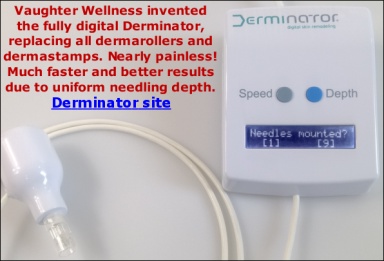Dermarolling / Microneedling / Will the roller leave tiny prick marks on facial skin?
« on: June 17, 2010, 08:21:14 AM »I'm not sure about how much of an expert she is in skin matters (there is quite a difference between a beauty expert and a dermatologist or plastic surgeon). Of course it is impossible to prove a negative and perhaps there do exist people who end up with permanent prick marks, so all I can do is advise you to do a test patch on your thigh first. If your skin responds normally, then you can do a small test patch on your face. Again, if you respond normally, you can do the rest of your face a few days later. Facial skin differs from other skin in that it has a large number of sebaceous glands, visible as "large pores". Those glands can become more prominent after rolling due to swelling, but that should subside rather quickly.
If dermarolling the face would really have a risk of permanent marks, I assume plastic surgeons would not vigorously roll the face with 3 mm needles as seen in the picture below:
Their typical customer is often rich enough to sue for damages if they end up with permanent scars, so plastic surgeons would not continue to offer this treatment if this was the case. Be advised that rolling with 3 mm needles is not at all required for very good results. 3 mm needles penetrate so deep that the face becomes a bloody mess. There is no need to go that deep. This is the opinion of the patent holder of the Dermaroller™ and he is not alone in this. It seems that plastic surgeons roll with such long needles in order to impress their clients, giving the impression that they must visit a clinic instead of home-roll for good results.
If you are interested in seeing how the skin looks directly after rolling vigorously and pushing deeply with a 1.5 mm roller, look at this picture:
This is the leg of a 40 year old customer of ours, who allowed us to use this image. No blood involved with 1.5 mm rollers. The image below is a magnified closeup (about 3 x actual size) of the leg right after rolling. Note how there is not even pinpoint bleeding. And the absence of any "holes". The "holes" immediately close and the red prick pattern disappears very quickly. She will make a picture a few days from now, to demonstrate that nothing visible remains. The same is the case with the skin on the face. However we can't be absolutely certain that there aren't any rare exceptions, this is why we advise to do test patches first, to see whether your skin responds as it should.
I am not aware of any of our customers ending up with permanent facial prick marks, not even after having sold thousands of dermarollers. But that doesn't neccessarily mean it is impossible - hence the recommendation to do a small area first.
This picture has been taken a few days later but it looked the same the next day:
Weeks later, the skin looks indistinguishable from unrolled skin.





